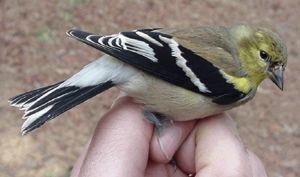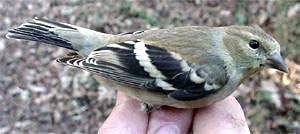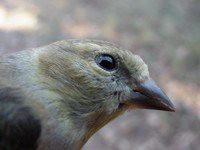 All photos & text © Hilton Pond Center
Dressing Down for Winter
All photos & text © Hilton Pond Center
Dressing Down for Winter
Almost everyone who feeds backyard birds during summer can recognize an American Goldfinch, even if folks do sometimes misname it the "wild canary." Indeed, brilliant yellow male goldfinches--with orange bill and jet-black wings, tail, and forehead (above)--do stand out canary-like against green foliage or blue sky and lift our spirits at Hilton Pond Center during those stifling "Dog Days" of August.
 Shortly after his chicks fledge, however, the male American Goldfinch trades spiffy breeding attire for something far more drab. His orange bill fades, and yellow body plumage and black forehead are replaced by olive-yellow feathers (right). From October through April or so, males look very much like females (below), which never acquire bright yellow body coloration. In winter, about the only way to tell male American Goldfinches from females is to look at the flight feathers. In nearly all males, wing and tail are jet black, while in females they are much less lustrous--almost a brownish-black. Shortly after his chicks fledge, however, the male American Goldfinch trades spiffy breeding attire for something far more drab. His orange bill fades, and yellow body plumage and black forehead are replaced by olive-yellow feathers (right). From October through April or so, males look very much like females (below), which never acquire bright yellow body coloration. In winter, about the only way to tell male American Goldfinches from females is to look at the flight feathers. In nearly all males, wing and tail are jet black, while in females they are much less lustrous--almost a brownish-black.
So what gives? Are winter males masquerading as females? Wouldn't the energy used by males in autumn to bring in a new set of drab winter feathers be better used to lay down fat before cold weather arrives? Why shouldn't males be bright yellow--or drab olive--all year 'round? And what's the significance of females being plain-colored even during summer?
 It's certainly in the best interest of the male American Goldfinch to be bright and showy during the breeding season. That's when he needs to impress the female. Males with brightest plumages are good at finding lots of pigment-rich food, so they're probably healthiest and most likely to find even more food for their nestlings. But being brightly colored has its shortcomings. Just as female goldfinches notice males with brilliant plumage, so do bird-eaters such as Sharp-shinned Hawks. During the breeding season, it's apparently worth the risk of possibly attracting a predator, but in winter--when reproduction isn't feasible because of cold weather and unpredictable food supplies--the male is better off being as inconspicuous as possible. Thus, it's worth expending the energy of going through a fall feather molt that helps the male blend in with his surroundings. It's certainly in the best interest of the male American Goldfinch to be bright and showy during the breeding season. That's when he needs to impress the female. Males with brightest plumages are good at finding lots of pigment-rich food, so they're probably healthiest and most likely to find even more food for their nestlings. But being brightly colored has its shortcomings. Just as female goldfinches notice males with brilliant plumage, so do bird-eaters such as Sharp-shinned Hawks. During the breeding season, it's apparently worth the risk of possibly attracting a predator, but in winter--when reproduction isn't feasible because of cold weather and unpredictable food supplies--the male is better off being as inconspicuous as possible. Thus, it's worth expending the energy of going through a fall feather molt that helps the male blend in with his surroundings.
Being inconspicuous is ALWAYS in a female goldfinch's best interest. In late summer, when she's sitting on a nest full of eggs or chicks, being brightly colored would make her far more visible to many predators. And since the female goldfinch typically chooses her mate--rather than vice versa--she doesn't need to be brilliant yellow to attract the male's attention. CAVEAT: Although breeding females ARE much drabber than males, their summer plumage typically does have more yellow than what they wear in winter. (Go figure.)
 There's one other interesting winter plumage characteristic in American Goldfinches. Experienced birders can tell at a glance that the bird in the photo at left is an adult male who's more than a year old. The clue is the bright yellow shoulder patch that develops in the fall of the male's second year. Until then, the patch is a checkerboard of tiny olive and black feathers similar to what shows in the female pictured above. So what's the wintertime function of this bright yellow epaulet in adult males? No one knows for sure, but perhaps it's one more way for a winter female at Hilton Pond Center to size up a prospective mate far in advance of next year's reproductive season. There's one other interesting winter plumage characteristic in American Goldfinches. Experienced birders can tell at a glance that the bird in the photo at left is an adult male who's more than a year old. The clue is the bright yellow shoulder patch that develops in the fall of the male's second year. Until then, the patch is a checkerboard of tiny olive and black feathers similar to what shows in the female pictured above. So what's the wintertime function of this bright yellow epaulet in adult males? No one knows for sure, but perhaps it's one more way for a winter female at Hilton Pond Center to size up a prospective mate far in advance of next year's reproductive season.
All photos & text © Hilton Pond Center
If you enjoy "This Week at Hilton Pond," please help Support
Hilton Pond Center for Piedmont Natural History
|


 Shortly after his chicks fledge, however, the male American Goldfinch trades spiffy breeding attire for something far more drab. His orange bill fades, and yellow body plumage and black forehead are replaced by olive-yellow feathers (right). From October through April or so, males look very much like females (below), which never acquire bright yellow body coloration. In winter, about the only way to tell male American Goldfinches from females is to look at the flight feathers. In nearly all males, wing and tail are jet black, while in females they are much less lustrous--almost a brownish-black.
Shortly after his chicks fledge, however, the male American Goldfinch trades spiffy breeding attire for something far more drab. His orange bill fades, and yellow body plumage and black forehead are replaced by olive-yellow feathers (right). From October through April or so, males look very much like females (below), which never acquire bright yellow body coloration. In winter, about the only way to tell male American Goldfinches from females is to look at the flight feathers. In nearly all males, wing and tail are jet black, while in females they are much less lustrous--almost a brownish-black. It's certainly in the best interest of the male American Goldfinch to be bright and showy during the breeding season. That's when he needs to impress the female. Males with brightest plumages are good at finding lots of pigment-rich food, so they're probably healthiest and most likely to find even more food for their nestlings. But being brightly colored has its shortcomings. Just as female goldfinches notice males with brilliant plumage, so do bird-eaters such as Sharp-shinned Hawks. During the breeding season, it's apparently worth the risk of possibly attracting a predator, but in winter--when reproduction isn't feasible because of cold weather and unpredictable food supplies--the male is better off being as inconspicuous as possible. Thus, it's worth expending the energy of going through a fall feather molt that helps the male blend in with his surroundings.
It's certainly in the best interest of the male American Goldfinch to be bright and showy during the breeding season. That's when he needs to impress the female. Males with brightest plumages are good at finding lots of pigment-rich food, so they're probably healthiest and most likely to find even more food for their nestlings. But being brightly colored has its shortcomings. Just as female goldfinches notice males with brilliant plumage, so do bird-eaters such as Sharp-shinned Hawks. During the breeding season, it's apparently worth the risk of possibly attracting a predator, but in winter--when reproduction isn't feasible because of cold weather and unpredictable food supplies--the male is better off being as inconspicuous as possible. Thus, it's worth expending the energy of going through a fall feather molt that helps the male blend in with his surroundings. There's one other interesting winter plumage characteristic in American Goldfinches. Experienced birders can tell at a glance that the bird in the photo at left is an adult male who's more than a year old. The clue is the bright yellow shoulder patch that develops in the fall of the male's second year. Until then, the patch is a checkerboard of tiny olive and black feathers similar to what shows in the female pictured above. So what's the wintertime function of this bright yellow epaulet in adult males? No one knows for sure, but perhaps it's one more way for a winter female at Hilton Pond Center to size up a prospective mate far in advance of next year's reproductive season.
There's one other interesting winter plumage characteristic in American Goldfinches. Experienced birders can tell at a glance that the bird in the photo at left is an adult male who's more than a year old. The clue is the bright yellow shoulder patch that develops in the fall of the male's second year. Until then, the patch is a checkerboard of tiny olive and black feathers similar to what shows in the female pictured above. So what's the wintertime function of this bright yellow epaulet in adult males? No one knows for sure, but perhaps it's one more way for a winter female at Hilton Pond Center to size up a prospective mate far in advance of next year's reproductive season.



